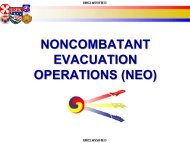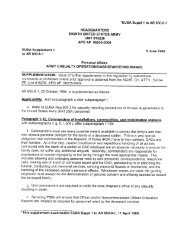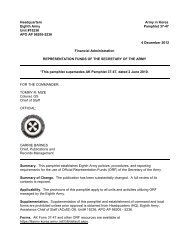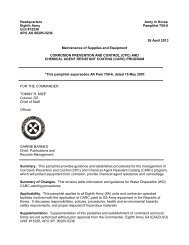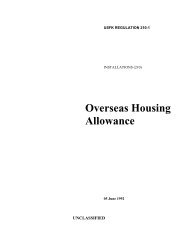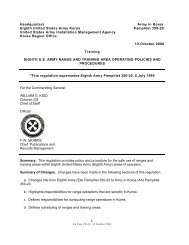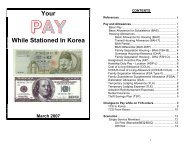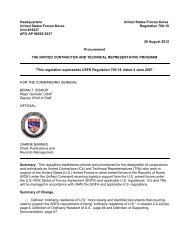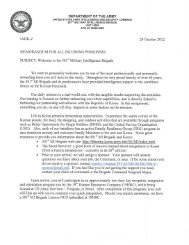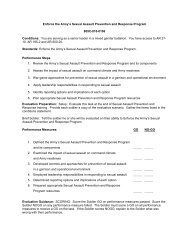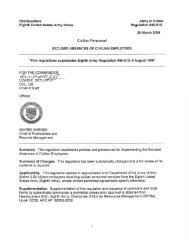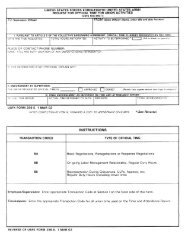CAS3 Staff Officer Guide - U.S. Army
CAS3 Staff Officer Guide - U.S. Army
CAS3 Staff Officer Guide - U.S. Army
Create successful ePaper yourself
Turn your PDF publications into a flip-book with our unique Google optimized e-Paper software.
17<br />
<strong>Staff</strong> <strong>Officer</strong>'s <strong>Guide</strong><br />
control and distribution of all incoming and outgoing accountable mail and distribution.<br />
d. Express Mail (USPS Express/Federal Express):<br />
(1) Use express mail next-day delivery service only when next day delivery is absolutely<br />
essential to meet mission requirements. Because of the greater cost, do not use express mail for the<br />
sole purpose of meeting a suspense date.<br />
(2) Activity deputy directors or executive officers must provide a signed request for use of<br />
express mail. Submit the request to the CMDB prior to 1500 to ensure next-day delivery.<br />
(3) Normally, the CMDB will not accept next-day delivery requests on Friday unless the<br />
activity has made special arrangements with the recipient for a person to be available on Saturday at<br />
the addressee’s office to accept custody of the mail.<br />
Electronic Mail (e-mail)<br />
a. E-mail is a powerful tool that can convey messages to a wide audience or a single addressee<br />
rapidly. However, e-mail is not meant to totally replace important face-to-face, telephonic, or hard<br />
copy communication. The best use of e-mail is to augment other channels of communication.<br />
b. E-mail can be used as the final transmission of official correspondence (taskers, policy<br />
directives, memorandums, etc.).<br />
c. Check your e-mail at least twice a day. Remember to call recipients to alert them of time<br />
sensitive e-mail traffic.<br />
d. Be brief, concise, and forceful in your messages. Use the military writing style. Work to<br />
minimize a message to only the visible space on the computer screen; avoid having the reader scroll<br />
or page down. If you have a lot to say, pass the message in an attached electronic file information<br />
paper or fact sheet. Format your e-mail logically, use the same rules for preparing the body of an<br />
informal memorandum. Use conventional capitalization and punctuation. Do not use all capital<br />
letters.<br />
e. Be sure you are not misunderstood. The message is just words; it cannot convey body<br />
language, speech inflection, or actions that provide clues to your mood when you speak face-to-face.<br />
Review your messages carefully before you send them; use edit and spell check before sending. Use<br />
bold face to emphasize or convey stronger emotions.<br />
f. Watch what you say. Consider any message you type and send to be in the public domain,<br />
unless you specifically tell the recipient not to forward the message to anyone else. If in doubt about<br />
message content, add a “DNR” (Do Not Retransmit) to the end of the message to indicate that you do<br />
not authorize the recipient to retransmit. Be aware that information contained in e-mail messages is<br />
information obtainable under the Freedom of Information Act.<br />
g. Send messages only to those individuals that have a need to know. Do not clutter the system<br />
with junk mail; this ties up network resources unnecessarily.<br />
h. Avoid sending file attachments to more than a few recipients and ensure that the size of the<br />
file attachment is small. To share large files and briefing charts, use the commonly shared file server<br />
or public folders. When transmitting correspondence as attachments to e-mail notes, add the words<br />
© 2005 <strong>CAS3</strong> For Instructional Purposes Only<br />
Compiled by www.<strong>Army</strong>Toolbag.com



